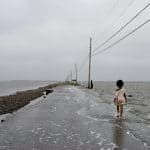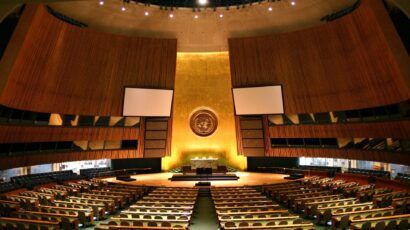Give peace a chance? Why sustainability requires more than stability
By Richard “Drew” Marcantonio | June 2, 2025
 Costa Rica, which has made ecotourism a cornerstone of its economy, is one of the few countries to score well on both peace and sustainability indicators. (Photo by Perry Grone on Unsplash)
Costa Rica, which has made ecotourism a cornerstone of its economy, is one of the few countries to score well on both peace and sustainability indicators. (Photo by Perry Grone on Unsplash)
Conflict and environmental risks are both on the rise around the world, and they’re often connected in complex ways. In the past five years, the number of global conflicts has doubled. At the same time, human activity is pushing the planet beyond the “safe operating space,” increasing the risk of instability.
Researchers studying the links between conflict and environmental change have found that war and violence almost always harm the environment. But does peace guarantee environmental stability, or vice versa? Some studies have found that sustainability and peace are indeed positively correlated. Countries with clean air, safe sanitation, and safe drinking water are more likely to score well on peaceful indicators than others. In other words, the research suggests that peace and sustainability go hand in hand. If true, pursuing one could help achieve the other. But what if it’s not that simple?
In our recent study, we examined this relationship more closely using three basic measures of ecological sustainability—carbon emissions per capita; ecological footprint; and material footprint—alongside two measures of peace: the Global Peace Index and the Positive Peace Index. We found the relationship between peace and sustainability may be more complicated—and even counterintuitive—than previously thought.
Our research shows that the most peaceful countries—those with little or no internal conflict—tend to be the most environmentally unsustainable. Switzerland, the United States, Finland, and France, for example, have some of the largest ecological footprints, while enjoying relative peace and stability within their borders. We also uncovered important links between a country’s ecological vulnerability, the types of conflict they engage in (whether between or within states), and their overall resource use.
The main discrepancy comes down to how we define and measure sustainability. Focusing on what a country produces and emits within its own borders versus what it consumes in total and the corresponding environmental impacts will lead to very different conclusions. This same tension shows up in how progress is measured, for example social and economic development versus corresponding ecological impacts, and it reflects broader challenges in accounting for sustainability in a comprehensive way.
To better understand the complex relationship between peace and sustainability, our study looked at three countries with very different profiles: the United States, the Democratic Republic of the Congo, and Switzerland. Each offers insight into how ecological impact and levels of peace can diverge in surprising ways.
In 2015, the United States was not experiencing conflict within its borders but was deeply engaged in military operations abroad, including Afghanistan, Iraq, Syria and other countries. It had an ecological footprint of 8.4 global hectares per capita (6.7 hectares above the sustainable per capita threshold), a material footprint of 32.4 tons per capita (25.6 tons above the sustainable threshold), and a per capita carbon dioxide emissions rate of 15.6 tons (13.6 tons above the sustainable per capita threshold ). It was ranked 19th of 163 in the Positive Peace Index (PPI), reflecting strong institutions and a stable society.
In 2015, The Democratic Republic of the Congo experienced intrastate conflict resulting in 384 deaths, it had an ecological footprint of 0.8 global hectares per capita (0.9 hectares below the sustainable per capita threshold), a material footprint of 2 tons per capita (4 tons below the sustainable threshold), and a per capita carbon dioxide emissions rate of 0.04 tons (1.7 tons below the sustainable per capita threshold). It was ranked 156th of 162 in the PPI. In other words, it experienced a relatively high level of intrastate conflict yet was well within its sustainable ecological footprint. This is despite unfolding environmental challenges around extractive industries like mining, much of which is for exported resources. And although there are justifiable concerns about ongoing deforestation in the Congo Basin, often by people who have been displaced by conflict and need to clear land for survival, it still pales in comparison to historical rates of deforestation in, for example, the United States, which logged two-thirds of its forests by 1920.
Switzerland experienced no intrastate conflicts and participated in no interstate conflicts in 2015, and had an ecological footprint of 4.9 global hectares per capita (3.2 hectares above the sustainable per capita threshold), a material footprint of 31.7 tons per capita (24.9 tons above the sustainable threshold), and a per capita carbon dioxide emissions rate of 4.72 tons (2.1 tons above the sustainable per capita threshold). It was ranked 3rd of 163 in the PPI. Like the United States, it consumed well beyond sustainable limits but enjoyed high levels of positive peace—albeit without participating in conflict in another country.
Together, these examples show that peace and sustainability do not always go hand in hand. The United States and Switzerland demonstrate that a country can be peaceful while still being ecologically unsustainable. Meanwhile, the Democratic Republic of the Congo shows that countries with minimal environmental impact can suffer from deep instability.
One reason for this pattern may lie in the nature of the conflicts themselves. Participating in conflicts abroad often demands large amounts of energy and resources, contributing to a country’s ecological burden. The US Department of Defense is the world’s single largest institutional consumer of oil, and contributed 400 million metric tons of greenhouse gases directly due to war-related fuel consumption during its 20-year global war on terror. By contrast, countries experiencing internal conflict are often poorer and consume fewer resources overall.
Our findings suggest that the relationship between ecological sustainability and peace is not inherently positive or automatic. In fact, in many cases, the two seem to move in opposite directions. But this doesn’t have to be the case.
Costa Rica offers a hopeful counterexample. In 2015, it was close to attaining ecological sustainability in all three measures. It was not involved in any domestic or international conflict, and, notably, it is one of only a handful of countries without a standing military. It also ranked in the top quarter of countries on the Positive Peace Index, suggesting that it has built both social stability and environmental responsibility into its national model.
Obviously, Costa Rica is an outlier—and most countries cannot follow the same path it has, by making ecotourism a key part of their economy. But its example does raise important questions about how countries can balance peace and sustainability in ways that are durable.
Ultimately, how policymakers measure, think about, and pursue both sustainability and peace matters. Results from previous studies and our findings show historical paths to peace through development are complicated. To date, there are few examples of peaceful and ecologically sustainable countries. Researchers need to explore further why this is the case and what can be done to positively realign two synchronous outcomes: comprehensive sustainability and sustainable peace.
Historical models of development and conflict resolution have often relied on patterns of economic growth that come with high environmental costs. Our findings, along with those from other recent studies, suggest that these paths to peace are not likely to succeed in the long run if they succeed by virtue of displacement or externalization of risks—especially if the goal is to address both rising global conflict and worsening ecological crises. Global peace and sustainability require a comprehensive approach to ensure one does not come at the expense of the other.
Together, we make the world safer.
The Bulletin elevates expert voices above the noise. But as an independent nonprofit organization, our operations depend on the support of readers like you. Help us continue to deliver quality journalism that holds leaders accountable. Your support of our work at any level is important. In return, we promise our coverage will be understandable, influential, vigilant, solution-oriented, and fair-minded. Together we can make a difference.
Keywords: conflict, peace, sustainability
Topics: Climate Change















“The main discrepancy comes down to how we define and measure sustainability.”
I believe that is only one part of the story. The disconnect in this research is in not only how we define sustainability but also peace. The absence of conflict is not = peace. The US is a good example of this gross inaccuracy where historical inequity and deep fissures abound but they were ignored for generations. I say it again: hiding/ suppressing conflict/ deep inequity is not = peace.
A large percentage of people in stable countries, which are generally wealthy countries ,complain strongly that their governments do too little to counter global heating. However, individually, most of those citizens use their wealth on wonderful holidays, homes and experiences and resent even being asked to reduce their energy use.